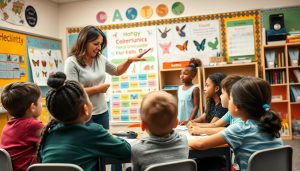Nearly five million students in the United States today are classified as English Language Learners (ELLs), and as a teacher, it’s important to understand the educational needs of these students. Here are some effective strategies to support the ELLs in your class that will also benefit the rest of your students!
USE CULTURALLY RELEVANT AND RESPONSIVE RESOURCES
Bring in stories from other cultures (especially those of your students) and connect them to content in your curriculum. In many cultures, storytelling is common, and students often enjoy acting out stories read in class or writing their own stories based on a piece of literature you read as a whole group. When tying culturally relevant information with your content, you are also providing a wonderful opportunity for you and your other students to learn about other cultures. What a great way for you to be able to celebrate diversity in your classroom while also promoting the learning and engagement of your ELL students.
ASSESS BACKGROUND KNOWLEDGE
Start by developing a relationship with your students and learning about where they are from. Providing students with the opportunity to connect content to their personal experiences is an excellent way to dig deeper and find out what they know. It can also be helpful to give some instruction in a student’s native language (when possible) as a supplement or to assess basic skills, especially when a student is just beginning to learn English. You will be amazed at how easy it is to translate most resources on Google and at how many language options there are to choose from!
DAILY LANGUAGE OBJECTIVES ACROSS THE CURRICULUM
In addition to daily objectives related to content, it’s important to set daily language objectives to target which reading, writing, listening, and/or speaking skills you will focus on that day. This will help to build literacy skills for all students in your classroom. Embedding language skills across the curriculum allows ELLs to work on those skills throughout the day, rather than only in isolation. This helps to build context and supports the students in learning specialized academic vocabulary. Like with any daily objective, make sure to refence it often throughout the lesson so students can explicitly see and understand the skills they are working on.
DIFFERENTIATE AND SCAFFOLD
Differentiating instruction is another effective strategy when working with ELLs. Providing opportunities to engage with content through multiple modalities gives students several opportunities to master a skill or understand a new idea. An ELL student may not have the spoken or written language to share what they know, but they could use art or music to show you instead. Another ELL student may have more advanced speaking skills but struggles with writing in which case you may provide them with the opportunity to give their test answers orally.
Another great strategy involves using visual aids and pictures as much as possible, especially with new vocabulary. Providing sentence stems in speaking and writing is another beneficial support for ELLs. A strategy called QSSSA can be a helpful way to scaffold information. When using this strategy, a teacher asks a Question, utilizes wait time, then gives a Signal that it’s time to answer. The teacher provides a Stem to help students form their answers, gives them the opportunity to Share, then Assesses to check for understanding.
MODEL, MODEL, MODEL
Modeling is one of the most powerful ways to help ELLs improve their language skills and master new content in the classroom. It’s important to speak slowly and properly enunciate sounds so that students learn the correct pronunciation of words. Sometimes it might even be necessary to practice the pronunciation of a difficult word with students and have them repeat it back to you. This can even be done with the whole class with the rational that you want to make sure everyone knows how to pronounce our vocabulary words correctly. Other effective modeling strategies include using visual models and working through examples with the class before they begin working on an assignment.
USE YOUR RESOURCES
If your school has ELL teachers or paraprofessionals, work closely with them and share ideas. Technology is another powerful resource. The links below contain some helpful resources, and there are many other great sources of ideas online.
https://www.edutopia.org/article/helpful-online-resources-teaching-ells
https://www.cultofpedagogy.com/supporting-esl-students-mainstream-classroom/
https://www.edutopia.org/article/strategy-giving-corrective-feedback-ells
https://www.edutopia.org/article/6-essential-strategies-teaching-english-language-learners
https://www.edutopia.org/article/5-effective-modeling-strategies-english-learners
PROMOTE A GROWTH MINDSET IN YOUR CLASSROOM
Having a growth mindset means that a person believes that their skills and intelligence can grow through effort. Our students who are learning English face significant challenges in the classroom, and helping them to believe in their ability to grow is essential in building their confidence. The resources below can help you get started in promoting a growth mindset in your classroom.
https://www.edsurge.com/news/2014-10-24-4-ways-to-encourage-a-growth-mindset-in-the-classroom
https://thecornerstoneforteachers.com/truth-for-teachers-podcast/routines-growth-mindset/
If you’d like to learn more about this and other education-related topics, Credits for Teachers provides self-paced online Professional Development courses for K12 teachers. Teachers who take our courses receive graduate credit from our university partner that can be used for salary advancement or license renewal. Learn more now!



